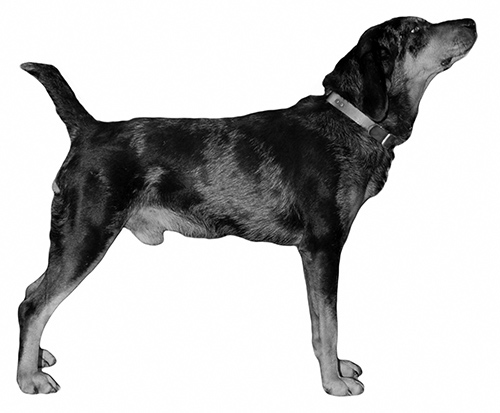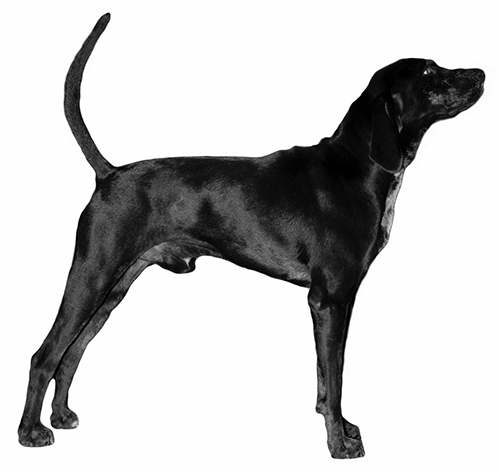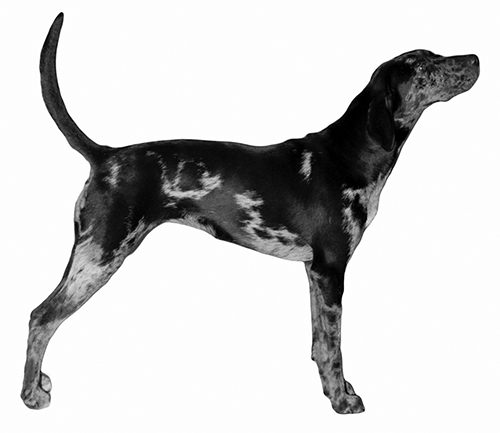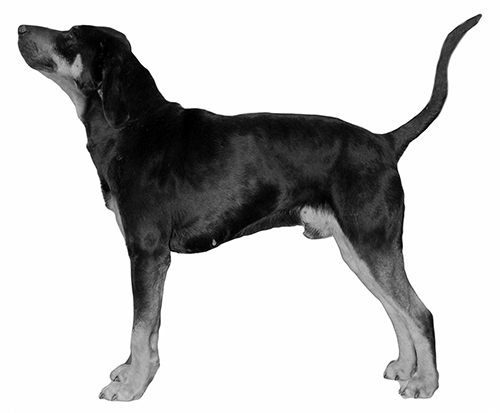American Leopard Hound
Scenthound Group
The goals and purposes of this breed standard include: to furnish guidelines for breeders who wish to maintain the quality of their breed and to improve it; to advance this breed to a state of similarity throughout the world; and to act as a guide for judges.
Breeders and judges have the responsibility to avoid any conditions or exaggerations that are detrimental to the health, welfare, essence and soundness of this breed, and must take the responsibility to see that these are not perpetuated. Though merle is an equally accepted color variation of the American Leopard Hound, it is strongly advised that merles not be bred to merles, because it often results in hereditary problems, to include blindness and deafness.
Any departure from the following should be considered a fault, and the seriousness with which the fault should be regarded should be in exact proportion to its degree and its effect upon the health and welfare of the dog and on the dog’s ability to perform its traditional work.
History
American Leopard Hounds are believed to be the descendants of dogs that were brought to the new world by Spanish conquistadors and crossed with native Mexican dogs. Early American settlers brought Leopard dogs from Mexico to hunt bear.
The Leopard Cur was recognized by UKC on November 1, 1998. The breed name was changed to American Leopard Hound May 1, 2008.
General Appearance
The American Leopard Hound is a powerful, agile tree dog of medium-to-large size. The body is just slightly longer than tall. Legs are long enough to allow the dog to move quickly and with agility in rough terrain. The head is broad, with a moderate stop and a heavy muzzle of moderate length. Ears are set high and drop. The tail is straight, set low, and may be any length. The coat is dense but close fitting. The American Leopard Hound should be evaluated as a hunting dog, and exaggerations or faults should be penalized in proportion to how much they interfere with the dog’s ability to hunt. Scars should neither be penalized nor regarded as proof of a dog’s working abilities.
Disqualifications: Unilateral or bilateral cryptorchid. Deaf. Blind.
Characteristics
The American Leopard Hound is an all-purpose tree dog, noted for stamina and the ability to withstand all extremes of temperature. This breed is noted for its extreme desire to please, which makes it an easy dog to train. They can handle a cold track and still be under the voice control of the handler. They are open trailers with a very strong desire to stay on track. They excel in their ability to hold game at bay without getting injured. Although they have been bred and used for all varieties of small game, the American Leopard Hound is also outstanding on big game such as bear and cougar.
Disqualifications: Viciousness or extreme shyness.
Head
The head is large but proportionate to the size of the body. When viewed from the side, the muzzle is slightly shorter than the skull and they are joined by a definite stop. The planes of the top lines of the skull and muzzle lie in parallel planes.
SKULL
The skull is flat and broad, tapering in width slightly toward the muzzle. Cheeks are muscular and prominent.
MUZZLE
The muzzle is of medium length and well proportioned to the rest of the head. Lips are tight and darkly pigmented.
TEETH
The American Leopard Hound has a complete set of evenly spaced white teeth meeting in a scissors bite.
Disqualifications: Overshot or undershot bite.
NOSE
Nose pigment is dark, usually black. Red merle-colored dogs have brown or liver colored noses and pigment.
EYES
Eyes are nearly round and set wide apart. Eye color may be any shade of yellow or brown. Leopard spotted dogs may have one or both blue eyes or wall eyes. Eye rims are tight and darkly pigmented. The expression is soft and appealing.
Disqualification: Blindness.
EARS
Ears are drop, of short-to-medium length, wide at the base, and set high.
Disqualification: Deafness.
Neck
The neck is slightly arched, strong, very well muscled, and of moderate length. The neck gradually widens from the nape and blends smoothly into the shoulders.
Forequarters
Shoulders are well laid back. The upper arm is long and wide, and forms an apparent 90-degree angle with the shoulder blade.
FORELEGS
The forelegs are strong and straight, with large, round bones. The elbows are set close to the body, but able to move freely in action. The pasterns are short, powerful, straight and flexible.
Body
A properly proportioned American Leopard Hound is slightly longer than tall. Back is broad, strong, of moderate length, and level, blending into a muscular, slightly arched loin with slight to moderate tuck-up. The croup slopes gently to the set on of the tail. The ribs extend well back and are well sprung out from the spine, then curve down and inward to form a deep body. The brisket extends to the elbow. Viewed from the front, the chest between the forelegs is muscular and wide. This is a dog bred for stamina and faults should be penalized to the degree that they detract from that goal.
Hindquarters
The hindquarters are strong and muscular. The bone, angulation, and musculature of the hindquarters are in balance with the forequarters.
HIND LEGS
The stifles are well bent, and the hocks are well let down. When the dog is standing, the short, strong rear pasterns are perpendicular to the ground, and when viewed from the rear they are parallel to one another.
Feet
The cat-like feet are of moderate size, round and compact, with well arched toes. Pads are large, tough, and well cushioned.


Tail
The tail is set on low and may be any length.
Coat
Coat is double and dense, but smooth. The outer coat is rough, and the undercoat is fine and wooly. This makes it possible for dogs to work in the thick underbrush for long periods of time after most dogs have given up.
Disqualifications: Excessively long hair, silky or wavy hair.

Color
Leopard spotted: yellow; black (may have brindle or tan trim); brindle; red and blue or mouse color. Any of these may also have white points and a white collar. No more than one-third white is allowed.
Disqualifications: A dog that is more than one-third white. Albinism. Any color or combination of colors other than described.
Height and Weight
Height at the withers for mature males is between 22 and 27 inches. For adult females, it is 21 to 25 inches. Mature males weigh between 45 and 75 pounds. Mature females weigh between 35 and 65 pounds. American Leopard Hounds are working dogs and should be presented in hard, muscular condition.
Gait
American Leopard Hound gait is smooth and effortless, with good reach of forequarters. Rear quarters have strong driving power, with hocks fully extending. Viewed from any position, legs turn neither in nor out, nor do feet cross or interfere with each other. As speed increases, feet tend to converge toward center line of balance.
Disqualifications
(A dog with a Disqualification must not be considered for placement in a bench show/conformation event, and must be reported to UKC.)
Unilateral or bilateral cryptorchid.
Viciousness or extreme shyness.
Albinism.
A dog that is more than one-third white.
Excessively long hair, silky or wavy hair.
Overshot or undershot bite.
Deafness.
Blindness.
Any color or combination of colors other than described.
The docking of tails and cropping of ears in America is legal and remains a personal choice. However, as an international registry, the United Kennel Club is aware that the practices of cropping and docking have been forbidden in some countries. In light of these developments, the United Kennel Club feels that no dog in any UKC event, including conformation, shall be penalized for a full tail or natural ears.
Note
Spayed and neutered dogs may compete in all UKC Licensed Coonhound Events, including bench shows, nite hunts, water races and field trials.


Looking for a Dog?
Find a dog that will fit your family.
Note: The breeders on this list are not endorsed by UKC.
Revised January 1, 2016
©Copyright 2000, United Kennel Club
